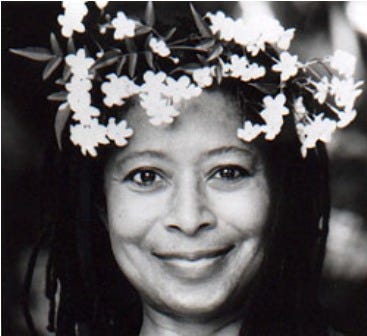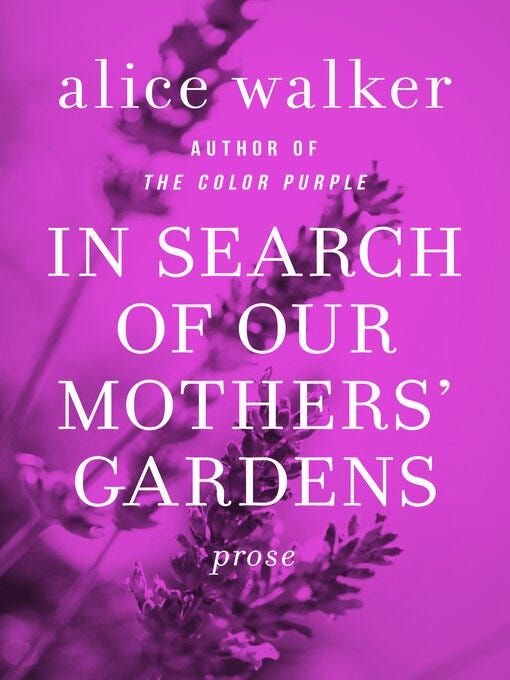“And if, in some gray rushing day, all of our black books are burned, it must be in my head and I must be able to drag it out and recite it, though it be bitter to the tongue and painful to the ears. For that is the role of the Black revolutionary artist. He must be a walking file cabinet of poems and songs and stories, of people, of places, of deeds, and misdeeds.” – Alice Walker, 1971


Sunday’s reading was a re-reading of The Unglamorous But Worthwhile Duties of the Black Revolutionary Artist, or of the Black Writer Who Simply Works and Writes by Alice Walker. This is a speech she gave in 1971 before an audience at Sarah Lawrence College. It is included in her phenomenal work, In Search of Our Mothers’ Gardens. As I read those jewels of wisdom, as I’ve done at least four times now, the same pressing question came to mind but with more gravity than ever before.
In the 21st Century, what is a Black revolutionary artist?
It is a question that demands an answer imperatively, and still, Walker’s speech lights the pathway some fifty plus years later. Black artistry has been the instrument of expression and revolution since the arrival of our enslaved ancestors. When the drums were banned, our ancestors created the spirit stick and the ring shout to call out to God for solace and offer praise. From our songs that were encoded with instructions for runaways to the quilts that were essentially maps, our artistry empowered us and gave us covert systems of resistance. The prose and poetry of the Harlem Renaissance and the Black Arts Movements, imbued with eloquence and rage, highlighted the plight of Blackness within an oppressive society, particularly during the mid twentieth century.
It is here that Walker’s speech/essay takes shape. In 1971, Black America was reckoning with the aftermath of the aforementioned movements and the recently passed Civil Rights Act of 1964. The assassinations of Dr. Martin Luther King Jr., Malcolm X, and Medgar Evers were still fresh in the collective memory of the People. Revolutionary artists were still needed but what would be their role? While the movements created a canon of works that uplifted the People and countered racist tropes, revolutionary artists still had a greater obligation. Walker stated that while she wished she could advise artists to simply create, that would not be ideal considering the urgent needs of the People. She mentioned a dilemma that is just as prevalent now as then–the literacy deficit in the Black community. Beautiful poems aside, what good would it serve the People if many of them were unable to read and truly garner meaning from it?
Walker points out, “The real revolution is always concerned with the least glamorous stuff. With raising a reading level from second grade to third. With simplifying history and writing it down (or reciting it) for the old folks. With helping illiterates fill out food stamp forms – for they must eat, revolution or not. The dull, frustrating work with our people is the work of the black revolutionary artist.”
Walker is positing a more practical approach for revolutionary artists. She was, in no way, insinuating that our art is unnecessary but instead it should be in conjunction with service to the People. At the same time, she stated that, “the work of the Black artist is also to create and to preserve what was created before him.” This charge to preserve our cultural heritage is perhaps more critical today than ever. The greatest concern I have is not so much about the erasure of our story in this country but rather if the People will remember, and in most cases, learn about it, specifically through well-researched and authentic sources.


It is no surprise that the film Sinners is stirring up discussions of Black/African heritage. This art demands us to remember and for many, to simply learn. But Ryan Coogler didn’t just create a work of art that was steeped in our cultural and historical foundations but also secured a deal with a Hollywood studio that ensures he is in full control of this production for the duration of his life. Hence, Coogler is applying the wisdom Walker stated in her speech/essay by having both an artistic purpose that serves the culture and an acumen for business that sets a standard for Black artists seeking both profitability (don’t play like that doesn’t matter), relevance, and control of the narrative.
This dual role of intentionally creating Black art as a means of uplift while serving the community in practical ways is a course of action that requires discipline, intellectual curiosity, artistic audacity, and perserverence. Most notably, in this era, it also means having technological savvy and conceptual agility to innovate beyond the deliberate obstacles in place to usurp sacrifice and progress. As evidenced in Walker’s guiding quote for this essay, the Black revolutionary artist must be willing to trek beyond their comfort zones in search of historical and cultural capital to reclaim, preserve, absorb and utilize to replenish and realign the Black masses.
Of course, this is a large undertaking and must happen within the Diasporic community. A force of global Black revolutionary artists can cause a paradigm shift by establishing a collective form of power and potentially toppling this rigid structure of Westernization that depends on the subjugation of the global majority to thrive. In short, this is art and service. It is done for the benefit of the People because the artist is of the People.
Chandra Kamaria is a writer, educator, public scholar and entrepreneur. To support her work, consider becoming a paid subscriber to The Literary Lightworker. You may also contribute by clicking this link: BuyMeACoffee




I needed this push - again. A part of family's history has been swimming in my head as stories to write. I've started them, then something stops me. In the wake of all we're dealing with now/again as a community I started questioning if it was important enough now because its so far in the past (Mid-20th century). I haven't seen Sinners (Lord knows I want to - I can't do horror movies) and knowing the celebration it gives to our past and you bringing it up here helps me as a Black writer today. I hope others do get it too. We need it. Thank you.
I love everything about this piece. It is both timely and necessary. It reminds us that artistry goes beyond aesthetics and popularity; it’s about connection and preserving culture. It’s about being there for the people, even in the least "glamorous" ways.